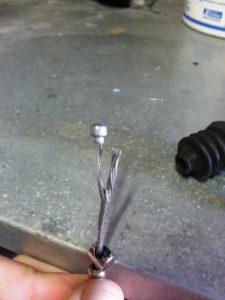Bad luck en route. That can happen with the best classic. With a modern motorcycle you then have a comprehensive mobility plan. We don't know that. We just have to see what is possible. And from personal experience we say that the coupling cable is often the culprit.
The coupling cable
Most of our engines still have a cable-operated clutch. A cheap, simple and effective system. But what if such a cable breaks? A motorcyclist known to us stood behind a car in front of the red traffic lights. He shifted to the first gear. Then his clutch cable broke. The engine mounted the car for him as an enthusiastic male would do the bitch of his dreams. That was a surprising and embarrassing 'Oops! Moment '. But it can happen. Fortunately, the (temporary) repair of such a cable is not rocket science. Only a few things are needed:
A sharp wire cutter, a screw bit and some patience. Those are not the elements that every motorcycle factory supplies with its product, but the purchase costs change and can make a considerable difference in the pleasure you experience during a ride. Cables usually break at the ends, just at the hinge point in the handle or at the clutch lever. Nowadays, handy boxes with some universal cable repair stuff are for sale. Handy to have on board.
That breaking occurs just as often due to metal fatigue
The cable itself must run smoothly. Sometimes that happens automatically through a Teflon coating, sometimes it needs to be lubricated. The pivot points in the clutch lever and at the clutch lever on the block must be clean and lightly lubricated. The barrels must be able to move freely in their holders. Buckling causes metal fatigue in the steel cable fibers. A broken clutch cable does not have to mean the end of the journey if the engine is not yet suffering from an excess of electronic control cousins. Motorcycle gearboxes are good to switch without clutch. Only driving off deserves attention. Depending on the muscles of the engine, put the gearbox in first or second gear. Start the engine. The horse will start kicking. But if it trots, then with the necessary extra traffic anticipation, you can drive well. But beware: that is the ultimate emergency solution.
A roadside repair
It is better to carry out a responsible roadside repair on the way. If the cable is broken along the way, cut the ragged end straight. The sharp side cutters to perform that operation must of course have been purchased well beforehand if you are not lucky enough to be stranded in front of a tool shop. Then slide the screw bar into place, clamp it between the jaws of the tongs in the on-board tool and tighten the screw firmly in the barrel. Leave as little of the inner cable as possible at the end of the screw cap. Excess length means that the barrel cannot turn in its holder and causes a flexural load in the cable and extra friction. The on-board tools usually do not include a screwdriver that is suitable for this job. But every tool shop gladly supplies them for change. The cable has now become slightly shorter, so it is likely that the length adjustment must be adjusted on the lever or engine block.
The idle stroke on the clutch lever must be approximately 2-3 mm with a cold block. That solution can last for years, but we still recommend purchasing and mounting a fresh outer and inner cable.
Again: You can drive well without a clutch. Only driving off is a trick. Without a starter engine there is some risk. The engine then, just like in the road racing of the past, must be 'pressed'. If the thing then runs away on a trot, it is handy to be on board at that time. Pushing the engine on is safer. Classics with a starter motor can simply be started in first or second gear. You usually do not receive a beauty prize for driving away. But that does not matter.






If you don't have to disassemble too much, I find it more convenient to have a complete clutch cable under the saddle. Screw barrels are usually not resistant to the coupling of a Laverda ...